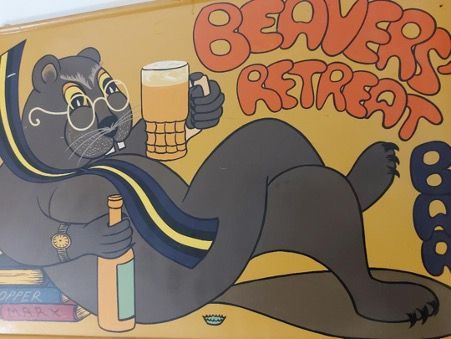Criminal Minds
Criminal Minds: aspects of criminal motivation and behaviour
After a two-and-a-half year hiatus following their last day-conference on Technology and Psychology, the London branch of the Open University Psychological Society (LOUPS) made a triumphant return to hosting in-person conferences with Criminal Minds. The event was held at our traditional stomping ground, the London School of Economics (LSE) however, we were in the new and impressive, Marshall Building, which had been under construction the last time we were there. From scaffolded-afar in 2020 to climbing the spiral staircase in 2022. Carpe diem.
'Criminal Minds' was comprised of three presentations. Open University’s Emeritus Professor Frederick Toates launched the conference with a talk about the subject behind the 5-star book he released this Spring written with his magnificent wife and collaborator, Dr Olga Coschug-Toates: 'Understanding Sexual Serial Killing'. Our second presentation, 'Armed Robbers: Identity and Cultural Mythscapes in the Lucky Country', came from City, University of London’s Professor Emmeline Taylor, who delivered a fascinating and sometimes chilling exploration of the identities of armed robbers, the challenges of studying in forensic settings, and the related importance of resilience and fortitude. Finally, Birmingham City University’s Dr Dan Rusu closed the conference with 'Life beyond murder: the reconstruction of identity amongst mandatory lifers': a revelatory lecture on a potentially divisive and provocative group. Each lecture ended with a question-and-answer session providing further points to consider, such as pornography, music, and prejudice. The three lectures also linked to one another making an incredible conference.
Prof. Frederick Toates: 'Understanding sexual serial-killing'
“I wish I weren’t here”. Professor Frederick Toates always delivers a formidable lecture, but this was an interesting opening statement! However, the sentiment related to the topic of his presentation: Serial Sexual Homicide. This is a tough topic and Fred noted the importance of nerves of steel in conducting this research though admitted he possesses “anything but”. Sometimes the worst crimes were committed by those who appeared the most ‘normal’. Fred and Olga’s work as documented in their book takes a biopsychosocial perspective and recognises that to understand an aberration, such as sexual serial killing, it is important to understand optimal functioning, for example, motivation, inhibition, and incentive salience. Fred referenced the work of his friends Kent Berridge and Terry Robinson who drew upon and developed the Toates model by notably splitting wanting and liking. For example, Fred used the working from home (WFH) context in which, when WFH, Fred feels the lure of the siren song of the refrigerator and its camembert treasures: “I want it, but I want to not want it”.
Fantasy, whether cheese or violence, activates pathways which release dopamine and have powerful psychological and physiological effects on an individual. A common theme among subjects in Fred and Olga’s book is fantasy or urges. Fred referenced sufferers of obsessive-compulsive disorder (OCD) and killers in that both may experience a negative or anti-social thought, but they have different reactions influenced by, for example, their developmental history. While difficult developmental backgrounds border on cliché in conversations around deviant behaviour, it is an enduring aspect among serial killers. However, as every good scientist knows; correlation does not equal causation. However, Fred noted that eradicating abuse, neglect, and bullying in schools would make a meaningful difference, so, while we should exercise caution when single explanations are suggested, there are nonetheless interventions which could be of benefit. In the Q&A, someone asked about the use of porn as an outlet. Fred suggested that violent porn does more harm than good and that he would favour banning it.
This was an excellent lecture to start the Criminal Minds conference. Fred delivered a thorough but respectful talk about serial sexual killing, which included examples from his and Olga’s book demonstrating the application of psychological research. In addition, direct quotes from some of these examples further consolidated our understanding and, while difficult to hear sometimes, are an undoubtedly valuable resource in developing the knowledge base of subversive populations: their words about their worlds.
Prof. Emmeline Taylor: 'Armed Robbers: Identity and Cultural Mythscapes in the Lucky Country'
Professor Emmeline Taylor delivered Criminal Minds’ second lecture, 'Armed Robbers: Identity and Cultural Mythscapes in the Lucky Country'. The differences between the attention that societies give to the quasi-celebrities of sexual serial killers and the almost invisible, save for the most infamous, population of armed robbers are immeasurable. However, Emmeline revealed the multifaceted identities of armed robbers: a particularly interesting criminal subculture as their crime of choice is low-reward and high-risk. Lecture 2 featured a serendipitous study which was both illuminating and demonstrated how studies can evolve throughout the research process. Moreover, Emmeline provided a comprehensive account of the bureaucratic wrangling involved in gaining access to participants in forensic settings, but the revelations in her research yielded insights that could not have come from other methods. Resilience and persistence ultimately led to intriguing data.
Emmeline’s study into armed robbers was conducted in Australia at a time when workplace injuries following violent robberies were worsening and causing increasing worry among companies’ loss prevention teams. Emmeline had initially been less interested in the specificities of armed robberies, favouring the emotions and the performance. Availability of participants led to incarcerated armed robbers being the most tangible participant pool, although access was slow to be granted, required endless patience, and relied upon a great deal of trust between all parties: Emmeline, the prison officers, and the participants. The level of trust needed is particularly interesting considering the frequently combative, oppositional relationship between incarcerated individuals and prison officers. Emmeline was an outsider to both parties, for example rumours circulated among the incarcerated that she was an undercover police officer: an inaccuracy which threatened her safety. Nevertheless, she persisted.
Her persistence paid off and the resulting data is extraordinary. Memorable examples include the comprehensive revelations about the cultural identity work of armed robbers, and the juxtaposition between an armed robber who declined the invitation to participate in Emmeline’s research yet made an incredible contribution. He wrote a helpful response letter to Emmeline’s request-for-participants combining meaningful information for the study with insider knowledge about the issues he saw as inhibitory that he recognised within her request so helped her in an unexpected way. On the other hand, Emmeline shared the only two occasions in which she was afraid. The first is a chilling instance of the wrong inmate being bought into the inescapable interview room at shift change. Terrifying. The second occasion was a tale who’s opening alone suggested the oeuvre of conference namesake drama series, Criminal Minds, yet Emmeline had kept calmer than I was merely hearing this story and she ended up with a friend. A friend who had been an armed robber and who decoded the specific vernacular. Emmeline has those nerves of steel to which Fred alluded!
Emmeline’s Q&A included questions about the adrenaline, demographics, and music of armed robbers. The rush invoked by a participant, “euphoric … surge of adrenaline”, starkly contrasts to the realities of incarceration, so it was questioned how the armed robbers therefore experience prison. Emmeline referenced a lack of data to address this incongruence but noted the presence of drugs and violence and posited the outcome of skydiving on the prisoners. Demographically, armed robbers are typically male, although women may play a peripheral role, and the socioeconomic background tended towards working class with clusters of ages, but there are outliers, and it is again necessary to refer to the data. My question conflated media depictions and one of the interesting performative aspects of armed robber identity culture: music. The film Baby Driver (2017) used music in a specific way, for example the ‘killer track’. Music was an important factor in the performative and transformative identities of armed robbers. A group of armed robbers nicknamed the Yugo Bandits were captured due to their penchant for Bulgarian thrash metal when neglected surviving music found in torched getaway cars allowed connecting of crimes. HipHop is a popular genre among armed robbers and Emmeline recounted a transcript from an interview including a notation where she and a participant had begun to sing/rap together. This was an excellent lecture combining the practical application of psychology in complex contexts, including multiple issues of safety, and the importance of keeping research diaries ["Hello there #DE200 #DE300 et al. students!"].
Dr. Dan Rusu: 'Life beyond murder: the reconstruction of identity amongst mandatory lifers'
Dr Dan Rusu presented the final session of the conference, 'Life beyond murder: the reconstruction of identity amongst mandatory lifers'. Early in the session, Dan used a mentimeter poll to gauge opinions on the statement, "Criminals laugh in our face: prison is not harsh enough to be a true deterrent", with the answer options, "agree/slightly agree/disagree/strongly disagree". Percentages shifted slightly but ~56% chose "Disagree"; perhaps unsurprising among a population with an interest in psychology and related disciplines? Opinions shared aloud included prisons being constructed as a ‘university’ or ‘finishing school of crime’, as well as inmates having access to some luxury goods, such as gaming consoles. However, to survive incarceration and adapt to the prison environment, individuals experience, for example, mortification of the self (Goffman, 1963) and prisonisation (Clemmer, 1940) so, there is a tension between the broader understanding of modern prisons with the minutiae of the lived experience. Great insight came from Dan’s interviews and the words of the ex-offenders. Although Dan’s study had five participants, the depth of the data which emerged from the interviews demonstrates the significance of qualitative and longitudinal research for scientific knowledge.
Dan's talk reflected on an aspect of the England and Wales Criminal Justice System: a life sentence is not a whole life sentence. A whole life order means that despite exceptional compassionate circumstances, an offender will never be released. Some of those serving these such terms had unsurprisingly been mentioned in Fred’s lecture. Therefore, a life sentence is not as it sounds and for those imprisoned on such terms, there will come a life after ‘life’ and all that entails. For example, the societal changes that have occurred during their incarceration are an alienating aspect of life after life because culturally normalised phenomena, such as technologically mediated communication and conspicuous consumption are less present in prison. However, one participant made an interesting point about competition not being a worthy concern to them, which demonstrated a departure from the significance of performative identities in prison. For example, Dan recalled being a young psychologist in a Romanian prison meeting room with an inmate crying about his circumstances, yet the following day the same inmate participated in the hypermasculinity and oppositional behaviour towards the psychologists: perhaps performative identity is more important during incarceration as a survival mechanism.
The fascinating aspects of Lecture 3 inevitably led to a lively Q&A session. An early point addressed the notion of identity in which individuals portray a version of themselves as being a common phenomenon, so how can it be avoided? Dan emphasised the importance of humanising within prison settings and discouraging the exaggerated masculinity identity. For example, HMP Grendon, familiar from DD310, is an interesting facility which challenges traditional punitive containment paradigms as inmates are ‘residents’ living in a therapeutic community involving votes and responsibilities. However, Dan’s answer to a question about abolishing prisons noted that there are some people who “should be locked up forever”. A question considering an evolutionary explanation for the prejudice that people display when they know of an individual’s past crimes, initiated a cross-room discussion touching upon cognitive misers, the construct of a ‘snap’ preceding a murder, hypervigilance, and reintegration. It would have been interesting to retake the mentimeter poll at the end of Lecture 3 to explore whether the percentages would have altered. However, my last scrawled note is about Grendon and how individuals apply to be residents and need to demonstrate they want to change, which arguably captures a core factor of Life beyond murder seen within the quotes from Dan’s research: the desire to change and forge a life after their life sentence.
Conclusion
Fred, Emmeline, and Dan made Criminal Minds a barnstorming return to LOUPS’ face to face conferences. Their lectures linked to one another in myriad ways, such as dramaturgical identity, the value of phenomenology, and humanising those often constructed as inhuman. The dramaturgy of identity refers to Goffman’s The Presentation of Self in Everyday Life (1959) in which identity is a performance. Identity was woven throughout Criminal Minds especially its performance, whether obscuring the aberrance within, playing music to fuel a role, or eradicating the former identity to survive the current. Phenomenology focuses on the subjective experiences of people. Each lecture included the contexts depicted through individuals’ quotes and conceptualisations, for example, violent compulsions, the hidden rules within sub-cultures, and the juxtapositions of time frozen while the world accelerated. Constructions of humanity, especially concerning media representations of criminals, have often been dehumanising. Criminal Minds featured sexual serial killers, armed robbers, and murderers. While it would be disingenuous to swerve the severity of these crimes, it would be duplicitous to fail to acknowledge the humanity within the research presented. Perhaps, the most fear-inducing, chilling, or provocative aspect of the conference was that the minds of criminals may not necessarily be so different to our minds.
Thank you to Fred, Emmeline, and Dan for their magnificent presentations. Thank you to Amada, David, and Sonia at LOUPS for arranging such an incredible conference to restart the London events. Amada, the “woman in orange”, introduced the conference and was our port-of call. David was king of troubleshooting and North Star should the fire alarm sound. Sonia was the LOUPS volunteer helping wherever needed. Thank you to all the attendees too! Many were new to LOUPS events and had heard of Criminal Minds through Eventbrite. There are many more events forthcoming so ensure you sign up to the LOUPS mailing list and follow LOUPS on Eventbrite through the links at the top of each LOUPS website page.
Books
Frederick Toates and Olga Coschug-Toates.
Emmeline Taylor.
https://www.waterstones.com/book/armed-robbers/emmeline-taylor/9780198855132.
Dan Rusu.
In production. Be ready.










